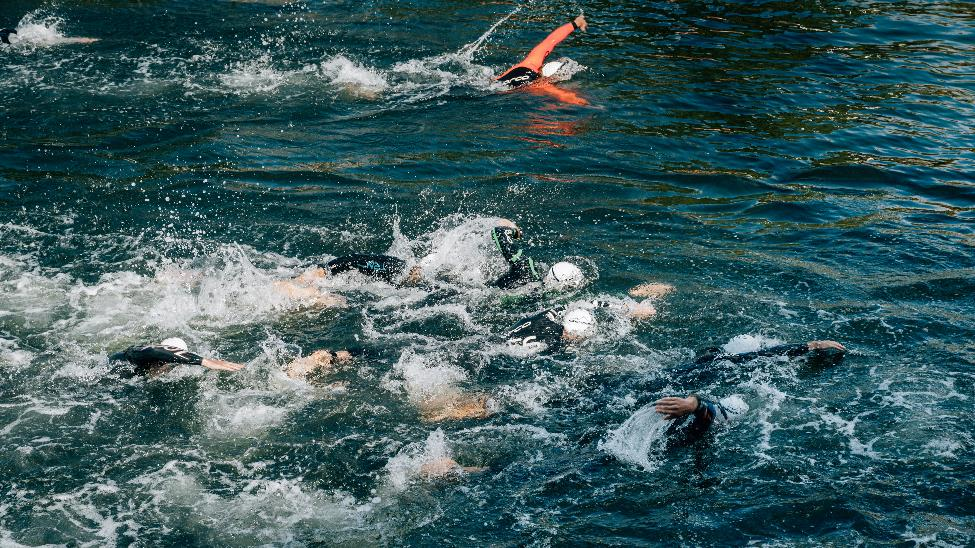Good preparation, proper equipment and the right tricks before a mass start are decisive for the outcome of the race. These are the most important points.
Simulate the start
In the last months before the competition, simulating the mass start is part of every swim training. No matter whether in the pool or in open water: the rougher and more violent the training, the more calm and serene the competition will be.
Examples for training:
- After a warm-up/swimming-in on land, a sprint or jump into the water follows. Then 200m crawl at a fast pace with fists, followed by 300m with clean technique and a steady swimming speed.
- More challenging: Take 5-breaths on the first 200m and alternate between side and front breathing (looking forward).
- In a group: 5×100 m crawl at a fast pace from a standstill (without pushing off the wall or ground). Every 20 m five strokes of chest arm pull with crawl at maximum speed.
- Solo swimmers: Go to indoor or outdoor pools at peak times and complete speed units in the crowd without disturbing the others.
It is important to consider “disruptive factors” and get used to a high initial pace over the first 200 to 300m before falling into a steady competition pace.
Optimizing equipment
- Weaker swimmers in particular would do well to carefully select and extensively test their equipment for the open water competition. The thicker the neoprene, the greater the buoyancy, which plays into the hands of swimmers with poor water conditions. Cheap, thick wetsuits have less flexibility in the shoulders, which is something you have to be prepared for.
- Special BodyGlide-Sticks, which are available in specialist triathlon shops, help against chafing on the neck.
- Hide the neoprene strap under the Velcro closure and supply the timing chip at the ankle under the neoprene closure.
- In case of a neoprene ban, at best a thin competition suit with high compression is an alternative to improve the water position.
- Goggles should be adjusted to the light conditions. Tinted lenses are appropriate when the morning sun is low.
- It is advantageous to wear two bathing caps each in open water competitions. The first bathing cap is made of silicone or (in cold temperatures) neoprene. Then the swimming goggles are put on your head before you put on the organizer’s bathing cap – often made of thin latex. This prevents the goggles from slipping or being torn off your head when you start. Swimming with two bathing caps is also a good idea to practice from time to time during training so as not to be surprised by the (tight) feeling.
- Also: Take off jewelry and piercings, because they can cause injuries in the mass start.
Warm up before the start
At cold water temperatures it makes little sense to swim in. It is therefore better to prepare an explosive water start with a warm-up on land. Ideas for this: Swing your arms, rotate your hips, bounce in place and jog lightly. Then skipping on the spot and fast arm circling paired with small and high jumps. At the end of the warm-up the pulse should have shot up a few times so that you are not surprised by the breathless pace in the mass start.
Line up according to performance
If you like fights and don’t have a problem with breathlessness and hyper acidic musculature, it is best to line up at the front in the middle of the starting field. All others may be better off starting at the edge of the field and being ranked according to their current performance, because there is less risk of being swamped, choked or having to adjust their glasses. If you are not a super swimmer, the first 200m of a triathlon can leave a lot of power and motivation behind you due to wrong ranking.
Remember landmarks
It is worth studying the competition course and the sequence of the buoy before the start. Do not rely on the announcement or on the swim in from the previous day. In addition, think about: Where are the prominent points that help with orientation? Trees, church towers, chimney tops? At what angle to the sun’s rays do you swim? If you mentally prepare for these points and regularly practice breathing forward during training, you will not be surprised by the competition.
Use a Slipstream
What is slipstream for cyclists is slipstream for swimmers. You benefit from other swimmers water shade behind their feet or offset next to them (shoulder at hip level). The trick is to find a suitable swimmer to draft on so that you don’t need too much energy to keep up, but also so that you don’t slow down too much. Important: Do not blindly rely on the orientation skills of the swimmer you follow, but check yourself with front breathing every now and then.
Prepare to exit
Walking out of swimming needs to be practiced, otherwise cramps and dizziness may occur. It is advisable to use a somewhat stronger leg stroke on the last few meters in the water to increase the blood supply to the muscles of the legs and feet. A change in the breathing rhythm (shortening to two-breathing or deliberately long exhalation into the water) has also proved to be effective before changing from swimming to running.
